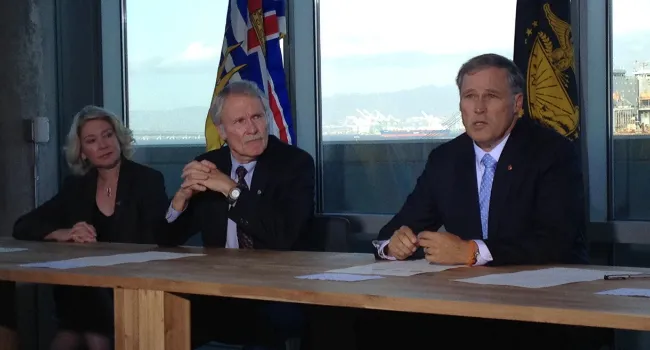Yesterday, the governors of California, Oregon and Washington, along with B.C. Premier Christy Clark, announced their Pacific Coast Action Plan on Climate and Energy. Speaking for the 53 million people they represent, the four leaders made substantive commitments around carbon pricing, low-carbon transportation and energy efficient buildings, and more.
The Action Plan is a positive step forward for the Pacific Northwest, not only because of the policy commitments made, but also because of the obvious effort to stress the economic opportunities associated with a transition to clean energy. Joint agreements such as these are helpful because they allow jurisdictions to share resources, and make it easier for them to move ahead with environmental policy when individual action isn’t always possible or effective. I liked the way Governor Jay Inslee of Washington State described the agreement:
“This Action Plan represents the best of what Pacific Coast governments are already doing, and calls on each of us to do more—together—to create jobs by leading in the clean energy economy, and to meet our moral obligation to future generations.”
The only real negative for me was the B.C. government’s effort to use the announcement to justify their liquefied natural gas (LNG) aspirations, which came across as a big stretch from the text of the agreement (more on this problem below). However, this shouldn’t take away from the positive commitments in the agreement and what it could mean for climate action in the region and beyond. Amidst a handful of good commitments, carbon pricing and low-carbon transportation jump out as the most significant.
Carbon pricing supporters — and proud of it
At a time when so many politicians see carbon pricing as a four-letter word, it was encouraging to see B.C. and California standing behind the positive steps they’ve already taken with their carbon tax and cap-and-trade approaches, respectively. Just as encouraging were the commitments from Washington and Oregon to implement their own carbon pricing approaches.
Both Washington and Oregon were part of the Western Climate Initiative but fell short in earlier efforts to implement cap-and-trade systems. It’s encouraging to see that they’re willing to try again, especially with knowledge of the political and policy challenges involved. It’s too early to know where those commitments will end up, but if both states are successful, it will be good news for carbon pricing across the continent. It could also be the spark that begins to thaw B.C.’s carbon tax freeze.
Low-carbon transportation for everyone
With transportation being a big part of the emissions picture in all four jurisdictions, overall success requires solid progess in this sector. The handful of transportation-related commitments include a new objective of having 10 per cent of new vehicles be electric by 2016, and plans for low-carbon fuel standards to be in force across the region.
B.C. and California will maintain their low-carbon fuel standards to require oil companies to reduce the impact of their transportation fuels, and Washington and Oregon will implement similar policies. All four jurisdictions have been challenged about the workability of low-carbon fuel standards, so this is a clear signal that the partners view the challenges as manageable and outweighed by the benefits of cleaner fuels.
A surprise appearance from B.C. LNG
As noted above, B.C. Environment Minister Mary Polak threw an LNG curveball in her media statement with a pitch about the benefits of exporting natural gas. Her praise for the overall agreement and the province’s carbon tax was fair, but it was a stretch to imply that the agreement supports B.C.’s aspirations to develop a LNG industry in the province.
The closest thing I could find to indicate support for LNG in the agreement is a section supporting markets and innovation for alternative fuels in commercial trucks, buses, rail, ports and marine transport. That section includes natural gas as one solution to lower greenhouse gas emissions, but you have to be thinking very creatively to consider that as justification for exporting LNG to Asia. If anything, the agreement’s reaffirmation of B.C.’s 2020 and 2050 targets should raise questions of the viability of large-scale LNG development in the province. As we’ve said before, developing LNG at the pace and scale intended by the province will make it impossible for B.C. to meet its emissions targets.
Next steps
The next steps in the Pacific Coast action plan will be fascinating to watch, particularly in Washington and Oregon, where a number of policy commitments have been made. If they have a good amount of success, we should see more energy efficient buildings and less polluting vehicles on the West Coast, which will help build support for the types of policies embedded in the new Pacific Coast agreement.
As Governor Inslee said, this agreement is about all of the partners doing more together. Hopefully they’re able to follow through with that kind of spirit.









